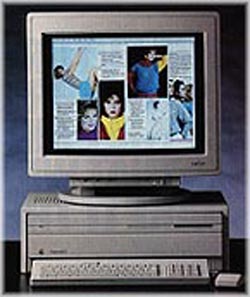
Macintosh II
Released in 1987, the Macintosh II was the first desktop Macintosh, with it lacking a built-in display. It was a high-end machine, designed for workstation use, and one of the only macs to use the Motorola 68020 processor.
Specifications
| Spec | Details |
|---|---|
| Release Date | March 1987 |
| Discontinuation Date | January 1990 |
| Processor | Motorola 68020 @16MHz FPU: Yes Bus Speed: 16MHz |
| RAM | 8x 30-pin SIMM Slots - 1 or 4MB Standard - 128MB Maximum |
| Hard Disk | 5.25" SCSI - 40 or 80MB Standard |
| Graphics | 256 or 512KB |
| Audio | Internal Speaker |
| Internal Drives | 2x Auto-inject 3.5" 800KB Floppy Drives (1.44MB upgrade available) |
| Expansion | 6x NuBus Slots |
| Networking | None |
| Other I/O | - 2x ADB - 2x Serial - 1x DB25 SCSI - 1x DB15 Video Out (on NuBus video card) - 1x Line Out |
| PRAM Battery | Two 1/2AA Lithium Batteries |
| Original Mac OS | System 2.0 |
| Maximum Mac OS | Mac OS 7.5.5 |
Upgrades
CPU Upgrade
68030 CPU upgrade cards were available.
SSD Upgrade
Check our page on SCSI SSD replacements for more info.
Resources
 Service Manual |
 Logic Board Schematic |
Capacitor Reference |
|---|
Common Faults & Maintenance
PRAM Battery Leaks
The Macintosh II used two 1/2AA Lithium batteries - one as the PRAM battery, and the "startup battery", which was required to jump-start the soft power circuit in the Macintosh. If this battery is dead, the Mac II won't power on. Early production Mac IIs used soldered 3V batteries from Varta, which rarely leak. Later production units switched to socketed 3.6V batteries, which used a different chemistry that is much more prone to leakage. The batteries should be removed and replaced regardless.
Capacitors
There were two board revisions of the Mac II. Revision A Mac IIs used axial electrolytic caps which are generally trouble free, while the Revision B boards used surface mount caps which are extremely prone to leaking and must be replaced.
The power supplies in the Mac II are generally reliable, but some of them have Rifa filter caps inside which can explode, releasing a bunch of nasty smoke.
Other Notes
Most original SCSI hard drives for these have gone bad, especially those made by Quantum, which suffer from sticky rubber bumpers in the head assembly.
The floppy drives in these often suffer from eject motor failures due to a gear that falls apart with age. This gear can be replaced without too much trouble.
The Mac II's case yellows with age. A retrobrite process can be used to correct this, if it bothers you. The plastic is not nearly as brittle as Macs from the 90s though.
Page last updated (MM/DD/YYYY): 03/03/2025
Update Reason: page rewritten
Back-Navigation
Home < Macintosh Portal < Mac II < Macintosh II (Original)